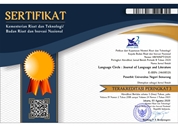DEVELOPING ENGLISH INTERACTIVE MULTIMEDIA STUDENTS’ E–WORKSHEET FOR FOURTH GRADERS OF ELEMENTARY SCHOOL
(1) Semarang State University
Abstract
Technology can change the paradigm of teacher-centered to be student-centered. One of the advantages of the technology is in making multimedia material. Multimedia material is one type of media that can be used as the solution to improve the student motivations in doing tasks in the worksheet. This study is a Research and Development of designing an E-Worksheet which is based on multimedia technology and internet network. There are seven stages to develop this E-Worksheet. They are Need Analysis, Product Design, Expert and Teacher Validation, First Product Revision, Field Test, Second Product Revision and Final Product. This study aims at developing interactive multimedia e–worksheet for the fourth graders of elementary school. It was tried out to the students and the results the students’ interest, motivation, and concentration in learning English, by using the Interactive Multimedia E-Worksheet was high. The level of difficulty of the E-Worksheet was well. The students’ activeness was very high. From these findings, it is suggested that English teachers need to learn how to design and develop multimedia material by using various computer programs. For Students, they should be control in utilizing computer and internet.
Keywords
Full Text:
PDFReferences
Alessi, S.M, & Trolip, S.R. 2001. Multimedia for Learning: Methods and Development. Massachussets: Allyn & Bacon.
Andrade, estela Lizbeth Munoz. Carlos Argelio Arevalo Mercado & Juan Manuel Gomez Reynoso. 2008. Learning Data Structures Using Multimedia-Interactive System. Retrieved from http://www.iima.org. [Accessed on 09/06/12].
Arikunto, S. 2006. Prosedur Penelitian: Suatu Pendekatan Praktik (Edisi Revisi VI). Jakarta: PT. Rineka Cipta.
Arkun, S. and Akkoyunlu, B. 2008. A study on the Development Process of a Multimedia Learning Environment According to ADDIE Model and Student’s Opinions of the Multimedia Learning Environment.http://www.ub.edu/multimedia/iem/[email protected] (7 January 2012)
BNSP. 2006. Standar Isi KTSP SD/MI. page 402-410. http://bsnp-indone sia.org/id/?page_id=103/ (9 January 2013)
Borg, W. R. & Gall, M. D. 2003. Educational Research: an introduction (7th edition). New York: Longman, Inc.
Breen, Michael P. 1984. Contemporary Paradigms in Syllabus Design Part II. Language Teaching / Volume 20 / Issue 03 / July 1987, pp 157-174. Retrieved from http://journals. cambridge.org/action/displayAbstract?fromPage=online&aid=2742768 (7 May 2012)
Brumfit, C. 1984. Communicative methodology in language teaching: The roles of fluency and accuracy. Cambridge and New York: Cambridge University Press.
Brown, H. D. 1980. Principles Language Learning and Teaching. New Jersey: Prentice Hall.
Brown, H. D. 1995. Teaching English Vocabulary. New Jersey: Prentice Hall.
Brown, H. D. 2001. Teaching by Principles. New Jersey: Longman.
Brown, H.D. 2004. Language Assessment: Principles and Classroom Practices. New York: Longman.
Brown, H.D. 2004. Testing in Language Programs: Principles and Classroom Practices. New York: McGrawHill Inc.
Dinas Pendidikan Kota Semarang. 2008. Silabus Pelajaran Bahasa Inggris Sekolah Dasar Kota Semarang (KTSP). Semarang: Dinas Pendidikan dan Kebudayaan
Depdiknas. 2006. Kurikulum Tingkat Satuan Pendidikan (KTSP). Jakarta: Depdiknas.
Depdiknas. 2006. BSNP. Jakarta: Depdiknas.
Dewi, Riyana. 2011. Developing Interactive Multimedia of the Contextual Vocabulary for the Third Grade Students of Elementary School. Unpublished S2 Thesis of Semarang State University.
Ellis, Rod. 1988. Classroom Second Language Development. New York: Prentice Hall.
Feez, S. 2002. Text-Based Syllabus Design. Sydney: Macquire University.
Harmer, Jeremy. 2001. The Practice of English Language Teaching. New York: Longman.
Harcleroad, F. F. 1977. AV Instruction Technology, Media, and Methods (5th Ed). New York: Mc-Graw Hill Company.
Gardner, Tremblay and Margoret S. 1997. The Role of Students' Attitudes and Motivation in Second Language Learning in Online Language Courses. Calico Journal Vol 23, No. 1 (September 2005).
Retrieved from https://calico.org/memberBrowse.php?action=article&id=131 [Accessed on 28/12/12]
Kasihani K.E. Suyanto. 2007. English For Young Learners. Jakarta: Bumi Aksara.
Larsen-Freeman, Diane. 2000. Techniques and Principles in Language Teaching. Oxford: Oxford University Press.
Lee, William. W, and D, L. Owens. 2004. Multimedia-Based Instructional Design. San Fransisco:Pfeiffer.
Matsuda and Shindo. 2002. Development of Cyber Theater titled "PINOCCHIO" and Cyber Theater Scenario Language: CTSL. IISCI Journal Volume 1 - Number 1 - Year 2003. Retrieved from http://www.iiisci.org/journal/CV$/sci/pdfs/P443092.pdf. [Accessed on 28/12/12]
Moore, M. G., & Kearsley, G. (1996). Distance education: A systems view. Boston, MA: Wadsworth Publishing.
Munadi, Yuhdi. 2008. Media Pembelajaran. Sebuah Pendekatan Baru. Jakarta: Gaung Persada Press.
Murcia, Marianne Celce. 2001. Teaching English as a Second or Foreign Language: Third Edition. New York, United States of America: Thomson Learning. Inc
Neo, Mai and Neo, ken. T. K. 2001. Innovative Teaching : Using Multimedia in A Problem-Based learning Environment. Educational Technology & Society 4 (4) 2001. Retrieved from http://www.ifets.info/ journals/4_4/neo.html. [Accessed on 27/12/12]
Norhayati, Abd. Mukti & Siew Pei Hwa. 2004. Malaysian Perspective: Designing Interactive Multimedia Learning Environment for Moral Values Education. Educational Technology and Society, 7 (4), 143-152 (2004). Retrieved from http://digilib.umm.ac.id/files/disk1/308/jiptummpp-gdl-jou-2009-norhayatia-15391-145B15D.pdf [Accessed on 27/12/12]
Nunan, D. 1991. Language Teaching Method: A Text Book for Teacher. Hearthfordshire: Prentice Hall International.
Nunan, D. 2002. Task-Based Language Teaching. New York: Cambridge University Press.
Richard E. Mayer. 2003. Nine Ways to Reduce Cognitive Load in Multimedia Learning. EDUCATIONAL PSYCHO-LOGIST, 38(1), 43–52 (2003). Retrieved from http://chua2.fiu. edu/nursing/anesthesiology/courses/ngr%206715%20insttech/slides/reduce_cognitive_load_in_me_mayer_moreno2003.pdf [Accessed on 27/12/12]
Scott, Wendy A. and Lisbeth H, Ytreberg. 1990. Teaching English to Children. New York: Longman, Inc.
Sugiyono. 2009. Metode Penelitian Pendidikan (Penekatan Kuantitatif, Kaulitatif, dan R&D). Bandung: Alfabeta.
Suyitno, Amin, dkk. 1997. Dasar dan Proses Pembelajaran Matematika. Semarang: FMIPA UNNES
Teoh, Belinda. S. P and Neo, Tse. Kian. 2007. Interactive Multimedia Learning: Students’ Attitudes and Learning Impact in An Animation Course. Retrieved from http://www.albany.edu/ etap/faculty/CarlaMeskill/publication/TESLIST.pdf. [Accessed on 2011/12/05]
Tsou, Wenli, et, al. 2006. Applying A Multimedia Storytelling Website in Foreign Language Learning. Computer & Education 47. Page: 17-28 (2012). http://www.elsevier.com/locate/compedu (7 January 2012)
Verdugo, Dolores. R and Belmonte, Isabel. A. 2007. Using Digital Stories to Improve Listening Comprehension with Spanish Young Learners of English. Language Learning & Technology February 2007, Volume 11, Number 1 pp. 87-101. Retrieved from http://llt.msu.edu/vol11num1/pdf/ramirez.pdf. [Accessed on 27/12/11]
Wichadee, S. 2010. Defining the Effectiv English Language Teacher: Students’ and Teachers’ Perspective. In A.M.
Refbacks
- There are currently no refbacks.

This work is licensed under a Creative Commons Attribution 4.0 International License

